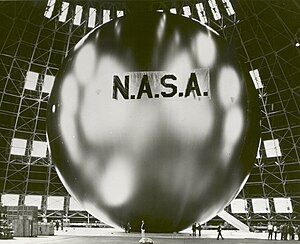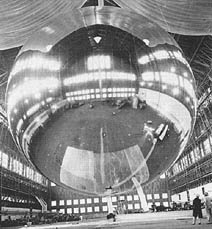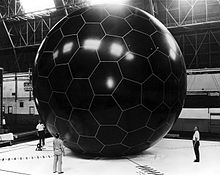Balloon satellite
A balloon satellite is an artificial earth satellite which , after reaching its orbit , is brought to its intended size by a gas filling. For this purpose, small amounts of gas are sufficient, which are already in the balloon envelope at takeoff and expand to a large volume due to the vacuum of space.
The heyday of the balloon satellites was between 1960 and 1975. On the one hand, they served passive radio communications and, on the other hand, because of their great brightness, they were a good high-quality target for geodetic purposes (large-scale stellar triangulation ).
Balloon satellites Echo-1 and Echo-2
The first such missile was Echo 1 , which was launched on August 12, 1960 by the USA on a 1600 km high orbit . It initially had a spherical shape of 30 meters with a metal-coated thin plastic shell made of Mylar and was used to test “passive” communications satellites and as a geodetic satellite. Its international COSPAR number was 6000901 (9th start of 1960, 1st component).
One of the first radio links was already successful over a distance of almost 4,000 km (between the east coast of the United States and California ). By the time Echo-1 burned up in 1968, its ongoing orbit measurement with satellite cameras of a few dozen ground stations had improved the knowledge of the exact earth figure by almost a factor of 10 (to a few meters).
Its successor was the similarly constructed Echo 2 with a diameter of 41 meters (1964 to approx. 1970). It circled about 400 km lower and no longer with an orbit inclination of 47 ° like Echo-1, but on an approximate polar orbit with an average inclination of 81 °. This made radio links and measurements possible even at higher latitudes . In addition to 30–50 professional ground stations, around 200 amateur astronomers in so-called moonwatch stations around the world contributed to the echo orbit determinations for the analysis of orbital disturbances and the earth's gravity field , who contributed around half of the weighted observations.
The radio-technical success of Echo-1 was given, but the "passive principle" ( reflection of radio waves on the balloon skin ) was soon replaced by active systems for communications technology. In particular, Telstar 1 (1962) and Intelsat I (1965) should be mentioned here. In addition to an intercontinentally exchanged television program, they could simultaneously broadcast several hundred audio channels .
Range of radio waves, visibility
How far a satellite is visible at such a great height can easily be calculated using the Pythagorean theorem . It turns out that it rises or sets in a 1500 km high circular orbit when it is 4600 km horizontal distance . The radio horizon is usually larger, the value fluctuates with the stratification of the earth's atmosphere .
So if two radio stations are 9000 km apart and the satellite orbit passes between them, they can receive their mutual reflection if the radio waves are sufficiently strong.
However, the optical visibility is lower than that of radio waves because
- the satellite must be illuminated by the sun
- the observer needs a dark sky (i.e. must be in the shadow of the earth on its twilight or night side .)
- In addition, the brightness of a sphere depends on the angle between the incidence of light and the observer - see the phases of the moon , and
- decreases sharply near the horizon because the atmospheric extinction swallows up to 90% of the light.
Nevertheless, for precise purposes of satellite geodesy it is no problem to observe a missile like Echo 1 down to an altitude of 20 ° - which corresponds to a distance of 2900 km. Therefore, theoretically distances between surveying points of over 5000 km can be bridged, and in practice at least 3–4000 km.
The articles on Echo 1 , PAGEOS and the world network offer further information on the visual or photographic observation of bright satellites and balloons and their geodetic use .
More balloon satellites
Air Density Explorer
To research the density of the high atmosphere, five satellites from the Explorer series were designed as balloons (Explorer 9, 19, 24 and 39 as well as DAD-B). While the air resistance of the balloon satellites was a problem when used as a communications satellite, it was even desirable here. Due to the low mass and the high air resistance, the density of the high atmosphere could easily be measured by measuring the change in orbit of these satellites over a longer period of time.
PAGEOS
PAGEOS was started especially for the so-called world network of satellite geodesy , for which around 20 full-time observation teams were on the move around the world until 1973 . With the tried and tested, fully electronic BC-4 cameras (1: 3 / focal length 30 or 45 cm), they took a total of 3000 usable photo plates on 46 ground stations , from which the stations could be calculated three-dimensionally to an average of 4 m. The coordinator of these campaigns was Hellmut Schmid from ETH Zurich .
The satellite geodesy with Echo 1 and 2, on the other hand, met all expectations not only for the planned two to three years, but for almost 10 years. That is why NASA launched the 30-meter balloon called PAGEOS. The name stands for “PAssiver GEOdätischer Satellit” in German and English - echoing GEOS , a successful active (electronic) satellite from 1965 .
There were three stations in the world network in Europe : Catania in Sicily, Hohenpeissenberg in Bavaria and Tromsø in northern Norway. To supplement the pure directional network , precise route measurements were necessary, which were measured on four continents - and also across Europe - with accuracies of 0.5 mm per km.
The world network now made it possible for the first time to calculate the “geodetic datum” ( geocentric position of the surveying systems) on different continents to a few meters and to mutually transform them . At the beginning of the 1970s it was also possible to calculate reliable values for almost 100 coefficients of the earth's gravitational field ( spherical function development up to degree and order 12-15).
PASCOMSAT and Gridsphere
To solve the high drag problem of passive balloon communication satellites, the United States Air Force launched a series of experimental satellites that consisted of wire mesh reflecting radio waves and shaped into a spherical shape by a balloon. The material of the balloon was chosen so that it sublimed under the influence of solar UV radiation . Thus, the balloon dissolved in orbit in a short time and left a spherical wire mesh that reflected the radio waves just as well as a real balloon satellite, but had only a fraction of the air resistance. Although this technology worked, there was no operational use, as active communication satellites had proven to be significantly more powerful, so that no more passive models were built.
See also
- Transhab : NASA's concept for inflatable space station modules from the 1990s
- Bigelow Expandable Activity Module : inflatable module on the International Space Station (since 2016)
Web links
Individual evidence
- ↑ National Museum of the United States Air Force Grid-Sphere Passive Communications Satellite ( Memento December 14, 2013 in the Internet Archive )



